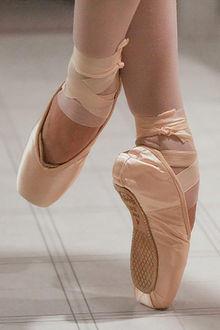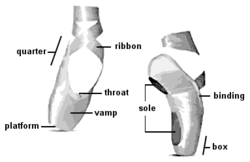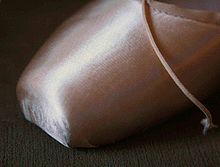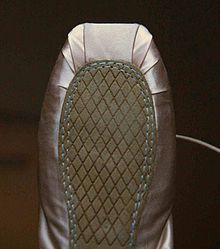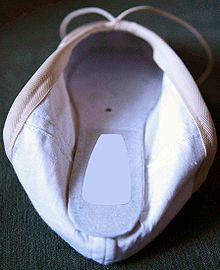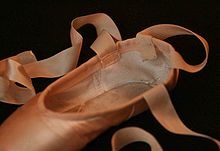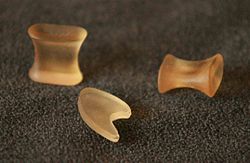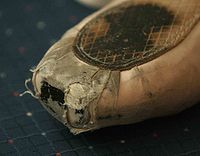- Pointe shoes
-
A pointe shoe is a type of shoe worn by ballet dancers when performing pointework. Pointe shoes developed from the desire for dancers to appear weightless and sylph-like and have evolved to enable dancers to dance on the tips of their toes (i.e., en pointe) for extended periods of time. They are normally worn by female dancers, though male dancers may wear them for unorthodox roles such as the ugly stepsisters in Cinderella, Bottom in A Midsummer Night's Dream, or men performing as women in dance companies such as Les Ballets Trockadero and Grandiva. They are manufactured in a variety of colors, most commonly in shades of light pink.
Contents
History of pointe shoes
 Marie Taglioni in the title role of La Sylphide, a ballet danced en pointe for the full length of the work.
Marie Taglioni in the title role of La Sylphide, a ballet danced en pointe for the full length of the work.
Women began to dance in ballet in 1681, twenty years after King Louis XIV of France ordered the founding of the Académie Royale de Danse. At that time, the standard women's ballet shoe had heels. Mid-18th century dancer Marie Camargo of the Paris Opéra Ballet was the first to wear a non-heeled shoe, enabling her to perform leaps that would have been difficult, if not impossible, in the more conventional shoes of the age. After the French Revolution, heels were completely eliminated from standard ballet shoes. These flat-bottomed predecessors of the modern pointe shoe were secured to the feet by ribbons and incorporated pleats under the toes to enable dancers to leap, execute turns, and fully extend their feet.The first dancers to rise up on their toes did so with the help of an invention by Charles Didelot in 1795. His "flying machine" lifted dancers upward, allowing them to stand on their toes before leaving the ground. This lightness and ethereal quality was well received by audiences and, as a result, choreographers began to look for ways to incorporate more pointework into their pieces.
As dance progressed into the 19th century, the emphasis on technical skill increased, as did the desire to dance en pointe without the aid of wires. When Marie Taglioni first danced La Sylphide en pointe, her shoes were nothing more than modified satin slippers; the soles were made of leather and the sides and toes were darned to help the shoes hold their shapes. Because the shoes of this period offered no support, dancers would pad their toes for comfort and rely on the strength of their feet and ankles for support.
The next substantially different form of pointe shoe appeared in Italy in the late 19th century. Dancers like Pierina Legnani wore shoes with a sturdy, flat platform at the front end of the shoe, rather than the more sharply pointed toe of earlier models. These shoes also included a box—made of layers of fabric—for containing the toes, and a stiffer, stronger sole. They were constructed without nails and the soles were only stiffened at the toes, making them nearly silent.
The birth of the modern pointe shoe is often attributed to the early 20th century Russian ballerina, Anna Pavlova, who was one of the most famous and influential dancers of her time. Pavlova had particularly high, arched insteps, which left her vulnerable to injury when dancing en pointe. She also had slender, tapered feet, resulting in excessive pressure applied to her big toes. To compensate for this, she would insert toughened leather soles into her shoes for extra support and would flatten and harden the toe area to form a box. While this practice made dancing en pointe easier for her, it was regarded by her peers as "cheating."
Construction
Every dancer has unique feet, with variations that include toe length and shape, arch flexibility, and mechanical strength. Consequently, most pointe shoe manufacturers produce more than one model of shoe, with each model offering a different fit. Regardless of the manufacturer or model, however, all pointe shoes share two important structural features that enable dancers to dance on the tips of their toes:
- A box within the front end of the shoe that encases and supports the dancer's toes.
- A shank, which is a piece of rigid material that serves to stiffen the sole so as to provide support for the arch of the en pointe foot.
The exterior of a pointe shoe is covered with fabric, thus concealing the box and other internal structural elements and lending an aesthetically pleasing look to the shoe. Most pointe shoes are covered with satin, but some are available with canvas exteriors. Pointe shoes are most often available in light pink colors and less commonly in black or white. Pointe shoes can often be ordered in other custom colors.
Box
The box is a hard enclosure within the front end of the shoe that encases and supports the dancer's toes. The front end of the box is flattened so as to form a platform upon which the dancer can balance, and fabric covers the exterior of the box for an aesthetically pleasing look.
Sole
In most pointe shoes, the sole is constructed from a single piece of leather that is attached to the shoe with adhesive and reinforced by stitching along its edges. The sole overlaps and secures the unfinished edges of the shoe's exterior fabric. Pointe shoes may be manufactured with either scraped soles, which provide superior traction, or buffed soles, which have a smoother surface for reduced traction.
Aesthetic appearance is of paramount importance for modern pointe shoes. To achieve an elegant appearance, the shoe's more decorative outer fabric is prominently featured, covering the maximum possible area of the shoe's visible surfaces. To this end, the sole is made of thin material to give it a minimal profile, and a margin of satin is artfully pleated around it so that the sole covers only part of the bottom of the shoe.
Shank
Shanks are typically made from leather, plastic, cardstock, or layers of glue-hardened burlap. The flexibility of a shank is determined by its thickness and the type of material used. A shank's thickness may be consistent throughout or it may vary along its length to produce different strengths at select points. For example, slits may be cut across a shank at demi-pointe to enhance roll through. Also, a shank's thickness may transition at some point along its length in order to implement differing strengths above and below the transition. Standard pointe shoes typically have a full shank, in which the shank runs the full length of the sole, or fractional (e.g., half or three-quarter) length shanks. Many pointe shoe manufacturers offer a choice of shank materials, and some will build shoes with customized shanks of varying stiffness and length.
Dancers will sometimes wear different pointe shoe models for different performance pieces. In such cases, the choreography often dictates the type of shank required; a lyrical style may call for a softer shoe, while an aggressive style with many turns is more easily performed in a hard, stiff shoe.
Ribbons and elastic band
A pointe shoe employs two fabric ribbons and an elastic band to secure it to the foot. Most of the work of securing shoes to feet is done by the ribbons. The two ribbons wrap around the dancer's ankle in opposite directions, overlapping one another so as to form a cross at the front. The ends are then tied together in a knot, which is then tucked under the ribbon on the inside of the ankle to hide it from view. The ends of the ribbons are never tied in a bow, as a bow knot might not hold together reliably. The elastic band—which traverses the front of the ankle below the ribbons—keeps the heel of the shoe in place against the foot when the dancer is en pointe.
The locations where the band and ribbons attach to a shoe is critical, as incorrect placement can result in a poorly fitting shoe. Optimal placement depends on the physical attributes of the foot to which it will be mated, and consequently the ribbons and elastic bands cannot be attached during the shoe manufacturing process. After acquiring a new pair of pointe shoes, a dancer must determine the appropriate attachment locations for the ribbons and elastic bands and then sew them, or arrange for them to be sewn, onto the shoes.
Demi-pointe shoe
A demi-pointe shoe, which is also variously called a break-down, pre-pointe, or soft-block shoe, shares many characteristics with pointe shoes. Its outer appearance resembles that of a pointe shoe and it has a toe box, although the box is softer and the wings (sides of the toe box) are typically not as deep as those found on pointe shoes. Demi-pointe shoes are secured to the feet with ribbons and elastic band in identical fashion to pointe shoes. Unlike pointe shoes, however, demi-pointe shoes have no shank and, as a result, they do not provide the support necessary for pointe work.
Demi-pointe shoes are most often used to train dancers who are new to pointe technique. They serve to acclimate dancers to the feel of wearing pointe shoes and to strengthen the ankles and feet in preparation for dancing en-pointe in pointe shoes. The toe box allows the dancer to experience the feel of a pointe shoe, while the insole and outsole work together to provide the resistance needed for developing foot and ankle strength.
Breaking in
Dancers break in, or soften, new pointe shoes in order to improve their fit and thus eliminate the discomfort caused by new shoes. Various methods are employed for breaking in new pointe shoes including deforming them against hard surfaces, striking them with blunt objects, wetting the toe boxes and then wearing them, and heating them to soften the glues, but these methods may shorten a pointe shoe's usable lifetime.
Accessories
After a pointe shoe is broken in, it is common that the toe box still does not provide a comfortable fit for the dancer's en pointe foot. To mitigate the discomfort caused by the unyielding box, dancers will often wear toe pads, which are most often fabric-covered gel pads that encapsulate and cushion the toes. Also, gel toe spacers are sometimes inserted between the toes to provide cushioning and to adjust toe alignments.
In addition to or in lieu of toe pads, some dancers may apply tape to their toes to reduce chafing and the likelihood of blisters. Lambswool is also used for this purpose by stretching it and wrapping it around the toes; after several such uses the lambswool becomes dense and custom fitted to the dancer's foot.
Lifetime
In the course of normal use, there are three predominant types of wear on a pointe shoe that will determine its useful lifetime. The most important of these is shank wear. As the body of the shoe is repetitively flexed, the shank gradually weakens and loses its ability to provide support. A pointe shoe is no longer serviceable when the shank breaks or becomes too soft to provide support. The second is the softening of the box and especially the platform on which the dancer balances.
The other primary type of wear involves the exterior fabric. In pointework, the front face and bottom edge of the toe box are subjected to friction against the performance surface. This friction will eventually wear through the shoe's outer fabric covering, thereby exposing the toe box and creating loose, frayed fabric edges. Unlike a weakened shank, damaged outer fabric does not affect the performance of a shoe. Due to its unprofessional appearance, however, damaged fabric may render the shoe unfit to wear in situations other than informal practice or rehearsal.
Under moderate usage, a pair of pointe shoes will typically last through ten to twenty hours of wear. For dance students, this often translates into weeks or months of serviceable use from a pair of pointe shoes. Professional dancers typically wear out pointe shoes much more quickly; a new pair may wear out in a single performance. As a result, most professional ballet companies provide shoe allowances for their dancers to defray the cost of frequent shoe replacement.
The lifetime of a pointe shoe depends on many factors, including:
- Usage. More aggressive dance styles and more frequent, longer durations of use will hasten wear.
- Dance technique. Improper technique subjects shoes to unusual stresses that may lead to premature failure.
- Fit. Well fitting pointe shoes encourage proper technique, which in turn leads to longer shoe life.
- Weight. Greater dancer weight exerts proportionally greater stresses to the shoes, leading to faster wear.
- Construction. Varying qualities and types of construction will yield different life expectancies.
- Shank material. The stiffness and integrity of various shank materials will degrade at varying rates.
- Breaking-in. The breaking-in process simulates accelerated wear, and thus may shorten the life of a shoe.
- Performance surface. Rough surfaces cause rapid wear of the exterior fabric, in contrast to smooth surfaces such as Marley floors, which minimize the rate of fabric wear.
See also
- Ballet shoes
- Freed of London
- Pointe shoes with heels (or Dori shoes)
- Capezio
References
- Barringer, Janice; Schlesinger, Sarah (2004) [1998]. The Pointe Book (2nd ed.). Princeton Book Company, Publishers. ISBN 0-87127-261-X.
- Reinhardt, Angela (2008) [2008]. Pointe shoes, tips and tricks (1st ed.). Dance Books Ltd.. ISBN 185273115X.
- Discover Ballet Shoes – Pointe shoes deconstructed.
Wikimedia Commons has media related to: Pointe shoes
Ballet terms Ballet d'action · Barre · Ballet blanc · Comic ballet · Contemporary ballet · Ballets de cour · Demi-soloist · Divertissement · Narrative ballet · Neoclassical ballet · Opéra-ballet · Pas de deux · Pas de quatre · Pas de trois · Pièce d'occasion · Pointe shoes · Romantic ballet · Turnout · Tutu · Variation
Categories:- Dancewear
- Shoes
- Sports footwear
- Ballet terminology
Wikimedia Foundation. 2010.

